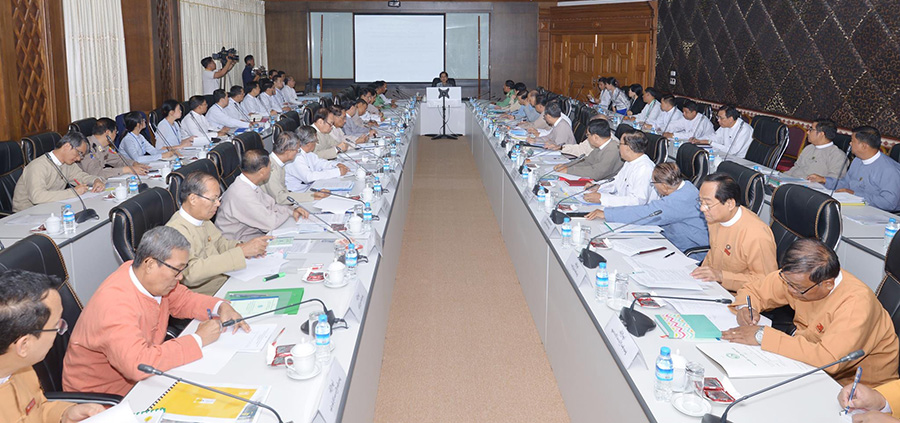YANGON—Thorough scrutiny of the projects under Beijing’s Belt and Road Initiative (BRI) is needed to assess their likely short- and long-term impacts on the country and the public, State Counselor Daw Aung San Suu Kyi said on Monday at the first meeting of a committee tasked with overseeing implementation of the projects.
During her first meeting with members of the Steering Committee for Implementation of the BRI in Myanmar, held in Naypyitaw, Daw Aung San Suu Kyi, who chairs the panel, emphasized the need “to make sure that the selected projects are in conformity with national plans, policies and domestic procedures.”
She added, however, that “Being a country located at a strategic position for the BRI, Myanmar needs to participate in the initiative,” and that joint activities under the scheme could bring mutual benefits to both sides.
Lying at the junction of South and Southeast Asia, and between the Indian Ocean and southwestern China’s landlocked Yunnan province, Myanmar occupies a unique geographical position within the ambitious international development plan.
In September last year, the China-Myanmar Economic Corridor (CMEC) agreement, a part of the BRI, was signed by both countries to construct basic infrastructure across key economic centers in Myanmar.
Unveiled in 2013, the BRI is Chinese President Xi Jinping’s signature foreign policy project. Also known as the Silk Road Economic Belt and the 21st-Century Maritime Silk Road, the project aims to build a network of roads, railroads and shipping lanes linking at least 70 countries from China to Europe passing through Central Asia, the Middle East and Russia, fostering trade and investment.
In November 2017, Chinese Foreign Minister Wang Yi announced a proposal to build the CMEC following a meeting with State Counselor Daw Aung San Suu Kyi in Naypyitaw. Wang said the economic corridor would enhance investment in development and trade under Chinese-Myanmar cooperation as part of the BRI.
The CMEC will stretch 1,700 km between the two countries from Kunming, the capital of China’s Yunnan Province, to Myanmar’s major economic centers. The first leg of the CMEC will link with Mandalay in central Myanmar. The corridor then branches east to Yangon and west to the Kyaukphyu SEZ.

Myanmar’s BRI steering committee comprises 25 members including 18 Union ministers (from ministries ranging from Home Affairs to Hotels and Tourism); five chief ministers (from Kachin, Mandalay, Rakhine, Yangon and Shan); the foreign affairs permanent secretary; and the chairman of the Naypyitaw Council. The committee plans to attend the 2nd Belt and Road Forum for International Cooperation to be held in Beijing in April.
Even as BRI projects face pushback among Southeast Asian countries, the vice chairman of China’s top economic planning agency pressed the State Counselor to work out an implementation plan for the CMEC during his visit to Naypyitaw in November.
Myanmar inked a separate framework agreement in November for China’s ambitious Kyaukphyu Special Economic Zone (SEZ), a key strategic project under the BRI that is expected to boost development in China’s landlocked Yunnan province and provide China with direct access to the Indian Ocean, allowing its oil imports to bypass the Strait of Malacca.
China has proposed 24 CMEC projects, and Myanmar has agreed to speed up work on nine of the biggest of these, according to the Mandalay Region finance and planning minister. These include the Kyaukphyu SEZ in the west, the New Yangon City Development in Yangon and border economic cooperation zones in Kachin and Shan states.
An estimated US$2 billion will be spent in the initial stages of the project. Experts are questioning how the infrastructure projects across Myanmar will be financed and have raised concerns about a debt trap. Despite these concerns, the government has yet to make public details of the CMEC.
Among three proposed border cooperation zones, the Muse-Ruili Border Economic Cooperation Zone will be the first one to be implemented, Shan State Minister for Planning and Economy U Soe Nyunt Lwin told The Irrawaddy.
In October, two state-owned companies, China Railway Eryuan Engineering Group (China Railway Group Ltd) and Myanmar Railways signed a memorandum of understanding (MoU) to begin studying a proposed railway line from Muse to Mandalay, which are envisioned as key hubs in a plan to improve connectivity in Southeast Asia.
At Monday’s meeting, Union Vice President U Myint Swe, who serves as vice chairman of the steering committee, stressed the importance of learning from the experiences of other countries in the region when implementing BRI projects, and of choosing only projects that are suitable and really necessary for the development of the country.
Also at the meeting, Union Commerce Minister Dr. Than Myint reported on the progress of establishing the Myanmar-China Border Economic Cooperation Zone; Union Planning and Finance Minister U Soe Win reported on the progress of the implementation of the Myanmar-China Economic Corridor; and Union Minister for International Cooperation U Kyaw Tin reported on preparations for the 2nd BRI Forum in Beijing.

















